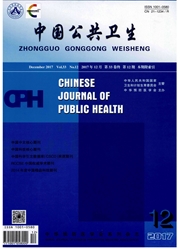

 中文摘要:
中文摘要:
目的 分析参加不同医保制度的高血压患者卫生服务利用差异。方法 使用全国卫生服务调查中黑龙江省数据,采用一般描述性分析、χ2检验、F检验进行数据分析。结果 城镇职工参保患者两周患病率(21.89%)、年住院率(4.34%)、住院实际报销比(51.83%)最高;两周就诊率(16.73%)最低。城镇居民参保患者两周患病未就诊率最高为44.44%;住院实际报销比最低为33.73%。新农合参保患者两周就诊率最高为42.08%;两周患病率、两周患病未就诊率、年住院率最低,分别为12.18%、16.97%、3.00%。参加不同医保制度的高血压患者在性别、文化程度、收入情况、高血压患病率、两周患病天数,两周患病率、两周就诊率、人均住院费方面差异均有统计学意义(P〈0.01)。结论 医疗保障制度可影响参保患者的卫生服务需要和利用。通过提高医疗保险的覆盖率,逐步缩小不同医疗保障制度保障水平的差距,逐步完善基层卫生机构慢病门诊补偿制度等方式,不断促进高血压患者卫生服务利用的公平。
 英文摘要:
英文摘要:
Objective To analyze the difference in health service utilization among hypertension patients with three different medical insurance systems.Methods Data on health service utilization among the residents in Heilongjiang province were extracted from the results of a national survey in 2013.General descriptive analysis,chi-square test,and F test were adopted in data analyses.Results Among the hypertension patients participating in different medical insurance systems,those with Basic Medical Insurance for Urban Residents had the highest two-week disease prevalence rate (21.89%),annual hospitalization rate (4.34%),and actual reimbursement ratio for hospitalization cost (51.83%)and the lowest two-week clinic visit rate (16.73%);the patients with Basic Medical Insurance for Urban Residents had the highest ratio of needing to visit a doctor but not in two weeks (44.44%) and the lowest actual reimbursement ratio for hospitalization cost (33.73%);the patients with New Rural Cooperative Medical System had the highest two-week clinic visit rate (42.08%) and the lowest two weeks disease prevalence rate (12.18%),ratio of needing to visit a doctor but not in two-weeks (16.97%),and annual hospitalization rate (3.00%).There were significant differences in gender,education level,income,hypertension prevalence,number of the days with illness in two-weeks,two-weeks disease prevalence rate,two-week clinic visit rate,and average hospitalization cost among the hypertension patients participating in different medical insurance systems (P〈0.01 for all).Conclusion The utilization of health service is different among hypertension patients participating in different types of medical insurance system.The difference in compensation level of various medical security system should be balanced to promote the equity of health service utilization in hypertensive patients.
 同期刊论文项目
同期刊论文项目
 同项目期刊论文
同项目期刊论文
 期刊信息
期刊信息
